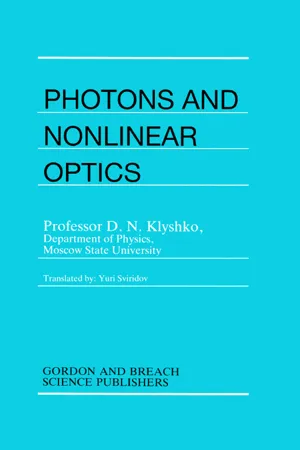
This is a test
- 438 pages
- English
- ePUB (mobile friendly)
- Available on iOS & Android
eBook - ePub
Photons Nonlinear Optics
Book details
Book preview
Table of contents
Citations
About This Book
This book provides an introduction to quantum optics for experimental physicists and for college students who have studied quantum mechanics. Its distinguishing feature is its emphasis on multimode fields with correlating different-frequency modes, notably on their phenomenological description and on the practical methods of generating them. The phenomena described in this book provide an opportunity to study nonrelativistic quantum electrodynamics and to master many important concepts of theoretical physics.
Frequently asked questions
At the moment all of our mobile-responsive ePub books are available to download via the app. Most of our PDFs are also available to download and we're working on making the final remaining ones downloadable now. Learn more here.
Both plans give you full access to the library and all of Perlego’s features. The only differences are the price and subscription period: With the annual plan you’ll save around 30% compared to 12 months on the monthly plan.
We are an online textbook subscription service, where you can get access to an entire online library for less than the price of a single book per month. With over 1 million books across 1000+ topics, we’ve got you covered! Learn more here.
Look out for the read-aloud symbol on your next book to see if you can listen to it. The read-aloud tool reads text aloud for you, highlighting the text as it is being read. You can pause it, speed it up and slow it down. Learn more here.
Yes, you can access Photons Nonlinear Optics by D.N. Klyshko in PDF and/or ePUB format, as well as other popular books in Technology & Engineering & Electrical Engineering & Telecommunications. We have over one million books available in our catalogue for you to explore.
Information
1 Introduction
IN THIS CHAPTER, we present a preliminary qualitative and, it is hoped, clear description of the basic properties of parametric (three-and four-photon) and polariton light scattering (Sections 1.1, 1.2, 1.3). In addition, Section 1.4 looks at some basic concepts in statistical optics and Section 1.5 gives some background information on the discovery of these and other related multiphoton effects. A more detailed phenomenological treatment of scattering processes is given in Chapters 6 and 7.
1.1 Parametric Scattering
When a beam of light passes through transparent homogenous material—whether gas, pure liquid, or a perfect crystal—a small part of the light’s energy is scattered in all directions by the atomic structure of the material. At low temperatures, ignoring quantum fluctuations, the atoms are fixed and light only changes its direction of propagation in scattering (elastic scattering), while, at high temperatures, the thermal motion of the atoms modulates the scattered light, changing not only the direction but also the frequency of the light (inelastic scattering). As a result, the frequency spectrum of scattered light repeats, subject to a shift into the optical region, the spectrum of the thermal motion of matter. For instance, in the case of ordinary Raman scattering, the spectrum of scattered light consists of several discrete components that are distant from the frequency of the incident light by an amount equal to the frequency of one of the normal vibrations of atoms in the molecule. As a rule, the frequency shift does not exceed a few percent in Raman scattering.
The Spectrum of Parametric Scattering
A characteristic feature of parametric scattering (PS) is the continuous spectrum of the scattered radiation, which, with short interruptions, may occupy the entire range from radio frequencies to the frequency of the incident light (pump), with the light of a given frequency ω1 being radiated by the material in a definite direction (Figure 1.1) that is dependent on the dispersion of the refractive index n(ω), according to the following equation:
(1) |
where k1 is the wave vector of the observed scattered light and is equal in magnitude to n1ω1/c = 2πn1/λ1 (λ1 is the wavelength in vacuum), k3 is the wave vector of the pump, and k2 is the wave vector of the idler wave, with a frequency of ω2 = ω3 − ω1. As the momentum of a photon in a medium is equal to ℏk (ℏ is Planck’s constant) (1), which relates to the case of three-photon parametric scattering, can be interpreted as the law of the conservation of momentum upon the interaction of three photons. It is also known as the phase-matching condition or the phase-velocity matching condition.
In the case of four-photon parametric scattering (or hyperparametric scattering, HPS) one has to add , the wave vector of the second incident light beam, which may have a different direction and a different frequency, to the right-hand side of (1). This effect is interpreted as the result of the interaction of four photons. Its value is proportional to the product of the intensities of the two incident beams.

Figure 1.1 In parame...
Table of contents
- Cover
- Half Title
- Title Page
- Copyright Page
- Dedication
- Table of Contents
- Preface
- List of Notation
- CHAPTER 1 INTRODUCTION
- CHAPTER 2 SOME INFORMATION ON QUANTUM MECHANICS AND STATISTICAL PHYSICS
- CHAPTER 3 THE PRINCIPLES OF QUANTUM OPTICS
- CHAPTER 4 THERMAL RADIATION IN THE LINEAR APPROXIMATION
- CHAPTER 5 THE INFLUENCE OF THE ANHARMONISM OF MATTER ON THERMAL RADIATION
- CHAPTER 6 PARAMETRIC SCATTERING
- CHAPTER 7 HYPERPARAMETRIC AND RAMAN SCATTERING
- APPENDIX THE GREEN FUNCTION AND TYPES OF FIELD POLARIZATION IN AN ANISOTROPIC ABSORBING MEDIUM
- References
- Subject Index